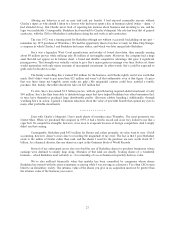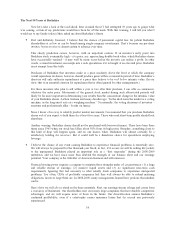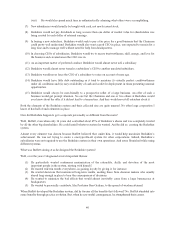Berkshire Hathaway 2014 Annual Report Download - page 33
Download and view the complete annual report
Please find page 33 of the 2014 Berkshire Hathaway annual report below. You can navigate through the pages in the report by either clicking on the pages listed below, or by using the keyword search tool below to find specific information within the annual report.Another major advantage we possess is the ability to buy pieces of wonderful businesses – a.k.a. common
stocks. That’s not a course of action open to most managements. Over our history, this strategic alternative has
proved to be very helpful; a broad range of options always sharpens decision-making. The businesses we are offered
by the stock market every day – in small pieces, to be sure – are often far more attractive than the businesses we are
concurrently being offered in their entirety. Additionally, the gains we’ve realized from marketable securities have
helped us make certain large acquisitions that would otherwise have been beyond our financial capabilities.
In effect, the world is Berkshire’s oyster – a world offering us a range of opportunities far beyond those
realistically open to most companies. We are limited, of course, to businesses whose economic prospects we can
evaluate. And that’s a serious limitation: Charlie and I have no idea what a great many companies will look like ten
years from now. But that limitation is much smaller than that borne by an executive whose experience has been
confined to a single industry. On top of that, we can profitably scale to a far larger size than the many businesses
that are constrained by the limited potential of the single industry in which they operate.
I mentioned earlier that See’s Candy had produced huge earnings compared to its modest capital
requirements. We would have loved, of course, to intelligently use those funds to expand our candy operation. But
our many attempts to do so were largely futile. So, without incurring tax inefficiencies or frictional costs, we have
used the excess funds generated by See’s to help purchase other businesses. If See’s had remained a stand-alone
company, its earnings would have had to be distributed to investors to redeploy, sometimes after being heavily
depleted by large taxes and, almost always, by significant frictional and agency costs.
************
Berkshire has one further advantage that has become increasingly important over the years: We are now the
home of choice for the owners and managers of many outstanding businesses.
Families that own successful businesses have multiple options when they contemplate sale. Frequently, the
best decision is to do nothing. There are worse things in life than having a prosperous business that one understands
well. But sitting tight is seldom recommended by Wall Street. (Don’t ask the barber whether you need a haircut.)
When one part of a family wishes to sell while others wish to continue, a public offering often makes
sense. But, when owners wish to cash out entirely, they usually consider one of two paths.
The first is sale to a competitor who is salivating at the possibility of wringing “synergies” from the
combining of the two companies. This buyer invariably contemplates getting rid of large numbers of the seller’s
associates, the very people who have helped the owner build his business. A caring owner, however – and there are
plenty of them – usually does not want to leave his long-time associates sadly singing the old country song: “She got
the goldmine, I got the shaft.”
The second choice for sellers is the Wall Street buyer. For some years, these purchasers accurately called
themselves “leveraged buyout firms.” When that term got a bad name in the early 1990s – remember RJR and
Barbarians at the Gate? – these buyers hastily relabeled themselves “private-equity.”
The name may have changed but that was all: Equity is dramatically reduced and debt is piled on in
virtually all private-equity purchases. Indeed, the amount that a private-equity purchaser offers to the seller is in part
determined by the buyer assessing the maximum amount of debt that can be placed on the acquired company.
31
























